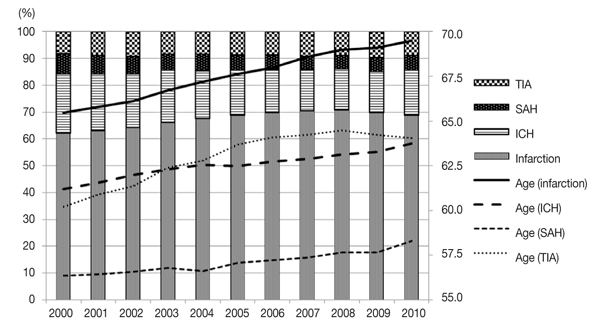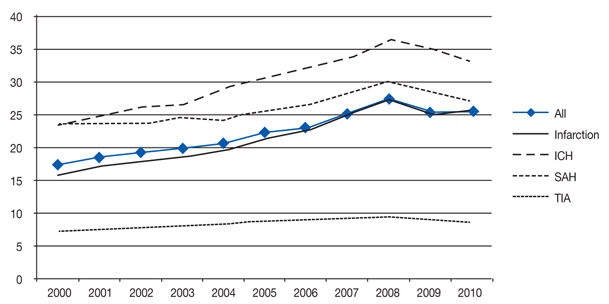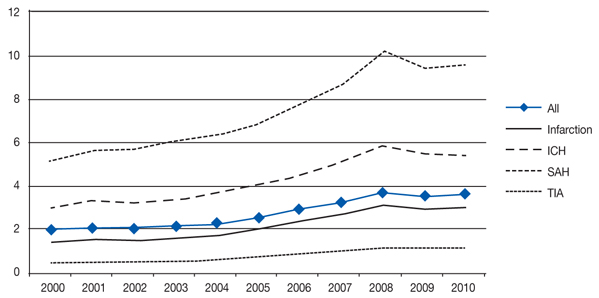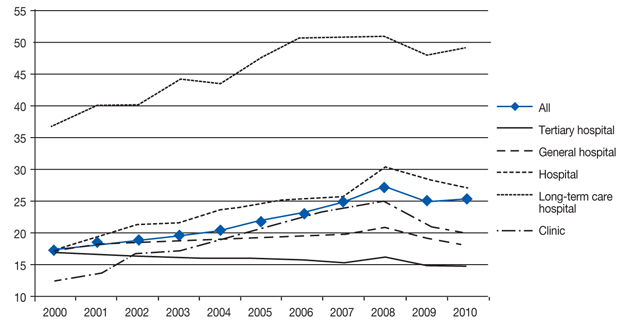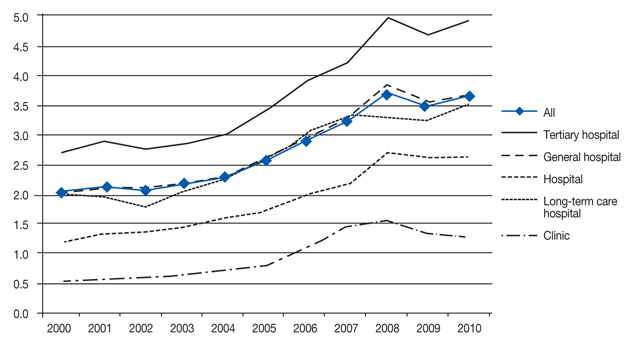J Korean Med Assoc.
2012 Oct;55(10):1014-1025. 10.5124/jkma.2012.55.10.1014.
Nationwide trends in stroke hospitalization over the past decade
- Affiliations
-
- 1Department of Humanities and Social Medicine, The Catholic University of Korea College of Medicine, Seoul, Korea.
- 2Department of Health Services Administration, Kyung Hee University School of Management, Seoul, Korea.
- 3Health Insurance Review & Assessment Service, Seoul, Korea.
- 4Department of Neurology, Kyung Hee University College of Medicine, Seoul, Korea. hsyoon96@medimail.co.kr
- KMID: 2192822
- DOI: http://doi.org/10.5124/jkma.2012.55.10.1014
Abstract
- Stroke is a major health problem in Korea. It is the second leading cause of death, and many stroke survivors are permanently disabled. Despite the high economic and social burden of stroke, little is known about utilization of health care services for sufficiently long follow-up periods. This study assessed nationwide patterns of hospitalization for inpatients with stroke from 2000 to 2010, using national health insurance claim data. Overall, during these 10 years, the number of stroke hospitalizations grew by a compound annual growth rate of 6.4%, and health care expenditures showed continued growth at a faster rate of 13.2%. These growth trends were also consistent in different types of hospitals as well as different stroke subtypes. However, the utilization patterns of inpatient services were different across hospital types, especially in lengths of hospital stay (LOS), health care expenditures, and proportions of stroke subtypes. Concerning the proportion of patients in different types of hospitals, there were sharp increases in the use of long-term care hospitals from 5% to 20% of all stroke patients while the proportion has decreased from 49% to 39% in general hospitals. The LOS was also different across hospital types: The longest average LOS of 49 days was shown in long-term care hospitals, while the tertiary hospitals showed the shortest LOS of 15. In conclusion, despite a continuing decline in stroke mortality due to improved survival, the burden of disease due to stroke is increasing. To manage this issue, monitoring the trends of health care expenditures in detail, as well as the incidence and mortality rates, would be useful. These efforts will result in understanding the factors contributing to the increasing burden and in identifying the efficient and effective utilization of limited health care resources.
Keyword
MeSH Terms
Figure
Cited by 2 articles
-
Carotid Artery Stenting
Jae-Hyeong Park, Jae-Hwan Lee
Korean Circ J. 2018;48(2):97-113. doi: 10.4070/kcj.2017.0208.Factors Associated with the Changes in Activities of Daily Living in Older Adults with Stroke: A Comparison of Home Care and Institutional Care
Woon-Sook Jung, Eun-Shil Yim
J Korean Acad Community Health Nurs. 2016;27(4):388-398. doi: 10.12799/jkachn.2016.27.4.388.
Reference
-
1. Strong K, Mathers C, Bonita R. Preventing stroke: saving lives around the world. Lancet Neurol. 2007. 6:182–187.2. World Health Organization. Causes of death 2008 summary tables [Internet]. cited 2012 Sep 17. Geneva: World Health Organization;Available from: http://www.who.int/entity/gho/mortality_burden_disease.
Article3. Statistics Korea. Causes of death statistics [Internet]. 2010. cited 2012 Sep 17. Daejeon: Statistics Korea;Available from: http://www.index.go.kr/egams/stts/jsp/potal/stts/PO_STTS_IdxMain.jsp?idx_cd=1012&bbs=INDX_001&clas_div=C&rootKey=1.48.0.
Article4. Feigin VL, Lawes CM, Bennett DA, Barker-Collo SL, Parag V. Worldwide stroke incidence and early case fatality reported in 56 population-based studies: a systematic review. Lancet Neurol. 2009. 8:355–369.
Article5. Di Carlo A. Human and economic burden of stroke. Age Ageing. 2009. 38:4–5.
Article6. Leys D, Henon H, Mackowiak-Cordoliani MA, Pasquier F. Poststroke dementia. Lancet Neurol. 2005. 4:752–759.
Article7. Young J, Forster A. Review of stroke rehabilitation. BMJ. 2007. 334:86–90.
Article8. Evers SM, Struijs JN, Ament AJ, van Genugten ML, Jager JH, van den Bos GA. International comparison of stroke cost studies. Stroke. 2004. 35:1209–1215.9. Lloyd-Jones D, Adams RJ, Brown TM, Carnethon M, Dai S, De Simone G, Ferguson TB, Ford E, Furie K, Gillespie C, Go A, Greenlund K, Haase N, Hailpern S, Ho PM, Howard V, Kissela B, Kittner S, Lackland D, Lisabeth L, Marelli A, McDermott MM, Meigs J, Mozaffarian D, Mussolino M, Nichol G, Roger VL, Rosamond W, Sacco R, Sorlie P, Roger VL, Thom T, Wasserthiel-Smoller S, Wong ND, Wylie-Rosett J. Writing Group Members. American Heart Association Statistics Committee and Stroke Statistics Subcommittee. Heart disease and stroke statistics: 2010 update. A report from the American Heart Association. Circulation. 2010. 121:e46–e215.10. Saka O, McGuire A, Wolfe C. Cost of stroke in the United Kingdom. Age Ageing. 2009. 38:27–32.
Article11. Lee KS, Bae HJ, Kim HS. Utilization of health care resources and costs of stroke patients: patients' perspective. J Korean Neurol Assoc. 2004. 22:583–589.
Article12. Kim KH, Park JY, Han CH. Analysis of medical charge for inpatients with stroke in tertiary hospital. Korean J Hosp Manage. 2009. 14:71–87.13. Chang H, Yoon SS, Kwon YD. Determinants of inpatient charges of acute stroke patients in two academic hospitals: comparison of intracerebral hemorrhage and cerebral infarction. J Korean Neurol Assoc. 2009. 27:215–222.14. Im JH, Lee KS, Kim KY, Hong NS, Lee SW, Bae HJ. Follow-up study on mortality in Korean stroke patients. J Korean Med Assoc. 2011. 54:1199–1208.
Article15. Kim HS, Lee KS, Bae HJ, Koh IS, Chang SH, Im DH, Heo JH. Changes in length of stay for neurological geriatric diseases in Korea between 2003 and 2007. J Clin Neurol. 2011. 7:148–155.
Article16. Kang HY, Lim SJ, Suh HS, Liew D. Estimating the lifetime economic burden of stroke according to the age of onset in South Korea: a cost of illness study. BMC Public Health. 2011. 11:646.
Article17. Hall MJ, Levant S, DeFrances CJ. Hospitalization for stroke in U.S. hospitals, 1989-2009. NCHS Data Brief. 2012. (95):1–8.
Article18. Tanne D, Koton S, Molshazki N, Goldbourt U, Shohat T, Tsabari R, Grossman E, Bornstein NM. Trends in management and outcome of hospitalized patients with acute stroke and transient ischemic attack: the National Acute Stroke Israeli (NASIS) Registry. Stroke. 2012. 43:2136–2141.19. World Health Organization. Global health observatory data repository: life expectancy [Internet]. cited 2012 Sep 17. Geneva: World Health Organization;Available from: http://apps.who.int/ghodata/?vid=710#.20. Lewsey JD, Jhund PS, Gillies M, Chalmers JW, Redpath A, Kelso L, Briggs A, Walters M, Langhorne P, Capewell S, McMurray JJ, MacIntyre K. Age- and sex-specific trends in fatal incidence and hospitalized incidence of stroke in Scotland, 1986 to 2005. Circ Cardiovasc Qual Outcomes. 2009. 2:475–483.21. Lee BC, Kim JH. Epidermiological and clinical features of occlusive cerebrovascular disease. J Korean Med Assoc. 2004. 47:604–610.22. De Peretti C, Nicolau J, Tuppin P, Schnitzler A, Woimant F. Acute and post-acute hospitalizations for stroke in France: recent improvements (2007-2009). Presse Med. 2012. 41:491–503.23. Shin YS, Choi BH, Shin HY, Hwang DK, Yun SJ. A policy report for the current situation of medical aid expenditure and improvement direction. 2005. Seoul: Korea Institute for Health and Social Affairs.24. Kim ES, Nam JJ, Kim MY, Ko IS, Lee DM, Kim KS. The current situation of medical aid utilization and improvement direction in long term utilizers. 2007. Seoul: Ministry of Health and Welfare.
Article25. Shin SM, Kim ES, Park CK, Lee HW. The medical use of the disabled among overusers of medical aid in Korea. J Prev Med Public Health. 2010. 43:35–41.
Article
- Full Text Links
- Actions
-
Cited
- CITED
-
- Close
- Share
- Similar articles
-
- National Trends in Medical Costs and Prognosis of Acute Ischemic Stroke Patients in Endovascular Thrombectomy Era: Analysis Using Medical Claim Data in Korea
- Recent Epidemiologic Trends of Stroke
- Registry-based stroke research in Taiwan: past and future
- Changes in Epidemiological Trends and Rehabilitation Usage in Neurological Diseases in Korea: Stroke
- Epidemiology and Functional Outcome of Acute Stroke Patients in Korea Using Nationwide data

